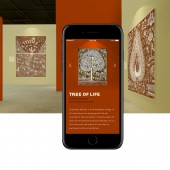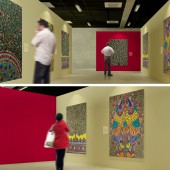
| THE AWARD |
| CATEGORIES |
| REGISTRATION |
| SUBMIT YOUR WORK |
| ENTRY INSTRUCTIONS |
| TERMS & CONDITIONS |
| PUBLICATIONS |
| DATES & FEES |
| METHODOLOGY |
| CONTACT |
| WINNERS |
| PRESS ROOM |
| GET INVOLVED |
| DESIGN PRIZE |
| DESIGN STORE |
| THE AWARD | JURY | CATEGORIES | REGISTRATION | PRESS | WINNERS | PUBLICATIONS | ENTRY INSTRUCTIONS |
The Kala Foundation Art Appreciation by Palak Bhatt |
Home > Winners > Design #121811 >Interview |
 |
|
FS: What is the main principle, idea and inspiration behind your design?
PB: India is known for its rich, colorful, and cultural vibrancy portrayed through different art mediums. Every region in India has its unique style of paintings. I hail from the western part of India and have grown up looking at various Indian art forms. There has long been a global market for Indian paintings, but interest in Indian art has lagged in the US. After moving to San Francisco, I noticed the lack of awareness of Indian Folk Paintings and would strongly like to promote them. I also want to help the artist from a remote part of India as they do not have access to the developed market. The Kala Foundation aims to establish a new platform to showcase the beautiful Indian Folk Paintings and make them more accessible to the international market.
FS: What has been your main focus in designing this work? Especially what did you want to achieve?
PB: My main focus was to bridge the gap between the need for Indian folk paintings in the US market and a platform to display the work by the artist from India to the international market.
FS: How long did it take you to design this particular concept?
PB: It took almost a year to work on this concept. The idea was constantly evolving as I was interacting with people and the art scene in the US. I started the concept work in December 2016 and developed and executed it by December 2017.
FS: Why did you design this particular concept? Was this design commissioned or did you decide to pursuit an inspiration?
PB: There has long been a global market for Indian paintings, but interest in Indian art has lagged in the US. After moving to San Francisco, I noticed the lack of awareness of Indian Folk Paintings, and it strongly inspired me to promote them.
FS: Is your design being produced or used by another company, or do you plan to sell or lease the production rights or do you intent to produce your work yourself?
PB: No, I do not plan to sell or lease the production rights. I intend to continue working on this concept by myself.
FS: What made you design this particular type of work?
PB: Art appreciation helps to look past what we see and open up the mindset by looking at different perspectives and interpretations of the art. This is what made me design this particular type of work.
FS: Where there any other designs and/or designers that helped the influence the design of your work?
PB: No, there were no designs or designers that helped influence the design of my work.
FS: Who is the target customer for his design?
PB: As I noticed the lack of awareness of Indian Folk Paintings in the US, I took this opportunity to work and create awareness by promoting them in the international market outside India.
FS: What sets this design apart from other similar or resembling concepts?
PB: Frankly, I have not come across a similar concept and that is what makes my design unique.
FS: How did you come up with the name for this design? What does it mean?
PB: As the design is about art appreciation and creating awareness of these Indian Folk Paintings, I decided to name the project that resembles the purpose and is easy to remember and pronounce. The name of this project is The Kala Foundation, where Kala means Art or Skill in Indian scripts.
FS: Which design tools did you use when you were working on this project?
PB: Softwares used for this project were Sketch for designing, InVision for prototypes, and Adobe Creative Cloud for editing and mocks.
FS: What is the most unique aspect of your design?
PB: The Kala Foundation focuses on three distinct forms of Indian Folk Paintings like Madhubani painting from the state Bihar, Gond painting from the state Madhya Pradesh, and Warli painting from the state of Maharashtra in India. Having the diverse art scene and culture present in India, this concept and platform can be used for similar other paintings and art forms, and this is the unique aspect of my design.
FS: Who did you collaborate with for this design? Did you work with people with technical / specialized skills?
PB: I collaborate with general people at one end and the folk artist on the other end during the research stage. I worked by myself when it came to designing, development, and execution.
FS: What is the role of technology in this particular design?
PB: Art enthusiasts can use the App to find paintings or order an existing Indian folk painting with a customization feature. The Kala Foundation website bridges the gap between the artist and art enthusiasts by introducing Indian folk paintings with the process and techniques.
FS: Is your design influenced by data or analytical research in any way? What kind of research did you conduct for making this design?
PB: The goal was to find new connections and then begin exploring the relevance, conceptually and visually. The process started by identifying camps that impact the concept. Finding connections helped me focus on the world around us and how it is interconnected. I set out to discuss the problem with others by creating and hosting a meeting with people from the target audience. I also volunteered at the Asian art museum in San Francisco to understand the art scene. For in-depth research, I went to India and met few artists, got to know their process and views on reviving their paintings to the international market. My design was influenced by on-ground reality based on real-life interviews.
FS: What are some of the challenges you faced during the design/realization of your concept?
PB: One of the challenges that I faced during this project was connecting the Indian Folk artist to the US market. The language was the main barrier for the artist. Through The Kala Foundation, the artists are given exposure by removing the language barrier and support by uplifting their livelihood.
FS: How did you decide to submit your design to an international design competition?
PB: I received an email about the competition from the A'Design award in addition to my friend's recommendation, and I decided to submit my design.
FS: What did you learn or how did you improve yourself during the designing of this work?
PB: I learned that my concept is broad and can extend to other cultures from different countries to create art awareness.
FS: Thank you for providing us with this opportunity to interview you.
A' Design Award and Competitions grants rights to press members and bloggers to use parts of this interview. This interview is provided as it is; DesignPRWire and A' Design Award and Competitions cannot be held responsible for the answers given by participating designers.
| SOCIAL |
| + Add to Likes / Favorites | Send to My Email | Comment | View Press-Release | Translations |





